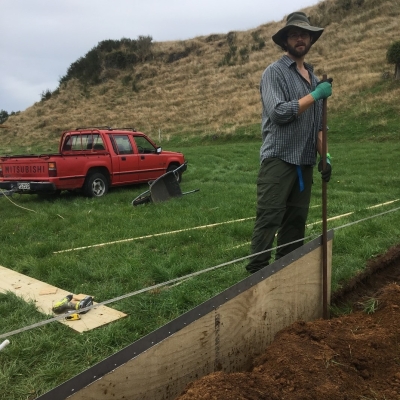
4 April 2017
Brian Levine, PhD student at Massey University, installing a V-notch weir to measure storm water flows at a Detainment Bund site in the Lake Rotorua catchment
Work has started on a three year ‘Phosphorus Mitigation Project’ to understand how Detainment Bunds can help prevent phosphorus moving from farm land to Lake Rotorua. Too much phosphorus and nitrogen can cause water quality problems in Lake Rotorua and other lakes and streams.
The project has been initiated by local farmers who are keen to trial new ways of minimising nutrient losses. Funding support comes from all the main NZ farming sectors, Ballance Agri-Nutrients, the Government’s Sustainable Farming Fund and three regional councils. Massey University is providing the lead science supervision with additional support from Waikato and Lincoln University staff. NIWA is also a project partner.
A Detainment Bund is a shallow temporary ponding area created by building a low earth bund across a valley floor. During high intensity rain events, the bund retains storm water runoff which carries sediment and phosphorus. After two to three days of ponding to enable particulate phosphorus particles to settle, the water is released slowly by pulling a drain plug installed in the base of the bund. Pasture in the ponding area can be then returned to full productive use without suffering significant damage from being flooded. To prevent the bund from being over-topped, a concrete riser on the upstream side connects to a culvert laid under the bund. The riser skims the surface layer of the ponded water after it has built up during a rain storm.
An earlier research project in 2013 provided ‘proof of concept’ for detainment bunds. Farmers were keen on the idea and 22 have now been built on farms in the region. The new project aims to take that knowledge to the next level and quantify just how much phosphorus can be captured and how best to operate these structures.
John Paterson, the project manager, says “Unlike nitrogen which leaches down through the soil profile, phosphorus does not readily leach but can be carried away by surface water runoff during high intensity rainfall events. These events only occur for a few hours at a time and usually just 5 to 6 times per year, so it makes good sense to target them for phosphorus treatment.”
The project research is led by Brian Levine, a Massey University PhD student from the USA. Brian says “It’s very important to measure the volumes and phosphorus loading of storm water both entering and leaving the Detainment Bund structures so that quantifiable results can be obtained for the amount of phosphorus that is removed by the Detainment Bund treatment process. We’ve just built a low timber weir upslope from one of the trial bunds so we can measure inflowing storm water”.
A working bee of local farmers finishes construction of a V-notch weir (centre) with plywood wings to funnel and measure storm water flow volumes on Jamie and Chris Paterson’s dairy farm in the Lake Rotorua catchment.
Lachlan McKenzie, chairman for the project, says “Rotorua farmers take water quality issues very seriously. The Rotorua districts farmers are taking the initiative to quantify (through this trial) the effectiveness of an innovative new way to help reduce storm water phosphorus loss from farms that could have application nationally” said Mr. McKenzie.
A field day on phosphorus mitigation with Detainment Bunds will be held at the J & C Paterson farm, 136 Stewart Road, Kaharoa, Rotorua from 1 to 3pm on Friday 12th May. All welcome!